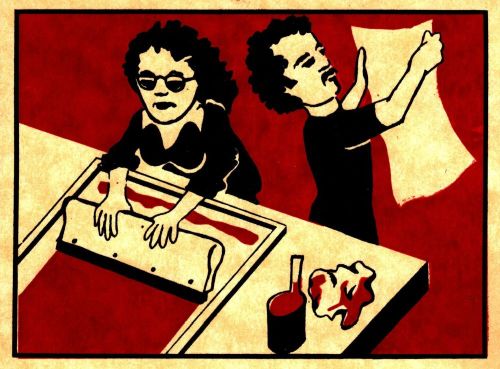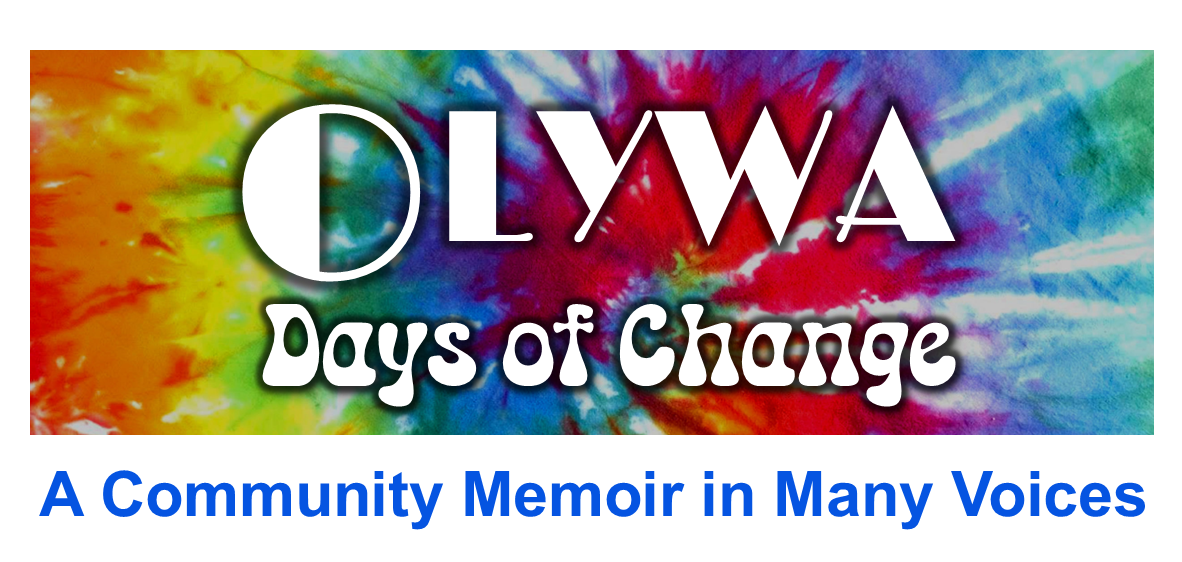- The Book Store – By Carol McKinley
This was the mid-1970s. Feminism and a growing number of feminist writers spurred the founding and growth of women-owned and operated presses. These were small businesses started on shoestring budgets by dedicated women willing and eager to get the words of feminist and lesbian philosophers, historians, novelists, poets, and artists into the public sphere. As a bookseller, I wanted to get their books to readers.
- Cafe Intermezzo – By Carolyn Street LaFond
I was coasting down the Fourth Avenue bridge in April 1977, having just recovered from a grueling tonsillectomy and on my way to my Special Ed teaching job at John Rogers Elementary. At the bottom of the incline I noticed a woman working on the large show windows of a shop next to another shop front with an identical set of windows indented from the street. The position of the windows and size of the adjoining space cried out to me, “There’s a great place for an espresso bar!”
- LLyn’s Tower: An All-Woman Construction Project – 1979 – By Jean Eberhardt
LLyn De Danaan, Anna Schlecht and I got together for an interview at LLyn’s house, but it quickly morphed into a boisterous reminiscence of the time that Nozama Construction, the newly minted construction collective, came to build an addition on her house to accommodate her growing family. Forty-five years later, this two-and-a-half-story addition, affectionately referred to as a tower by LLyn, still stands.
- Laura May Abraham Booker and the Rainbow Grocery/Restaurant – By Stephen Charak
They said, “Hey Laura May, there’s a grocery store for sale across the street.” I said, “What do I want a grocery store for?” Still, [I] went to look at the store. We looked in the windows, and boy was it a dive. It was a cigarette and beer stop. The drunks would stumble between Ben Moore’s and the Angelus Hotel. But still, it was a functional grocery store. Andrew had the background of being raised in [the grocery] business. His mother had a place in Hurley, Wisconsin, close to the shore of Lake Superior since 1940. And I had the experience of being the manager of a Food Co-op. So this vacant grocery store presented a great opportunity . . . I thought this was a really privileged position to be in, maintaining this old corner grocery store in the heart of town.
- Hard Rain Printing Collective Part 1 – By Don Martin
Indeed, it was the concept of workers seizing the means of production that inspired Grace and me to investigate the idea of running a worker-owned print shop. In the days before cell phones and the internet, print media was how we communicated, how we announced our events and rallies and theatrical productions, how we debated political change. We wanted to be pamphleteers. Thomas Paine and the Wobblies were our inspiration.
- Hard Rain Printing Collective – Part 2 – By Don Martin
We had been in the Division Street shop for a couple of years. Struggling, cold, and damp. Honing our skills. Learning from mistakes. We learned about printing standards and the allowable percentage of flawed prints or undercounts. We paid dues to the Graphic Arts International Union, in support of workers in the trade. It meant we could print a “union bug” on our work.
- $5 Blue Jeans – By Nancy Sigafoos
The popularity of blue jeans was at its zenith, and the leading manufacturers of denim (Levi Strauss, Wrangler, and Lee) had all made financial deals with secondhand organizations like Goodwill to destroy all blue jeans and jean jackets that came through their clearinghouses.
- Dice T-Shirts 1979 to 1989 – By Nancy Sigafoos
If you took a clothesline long enough to hang a thousand t-shirts in a row and hung every design I printed in chronological order, you would have a history of life in Olympia in the 1980s. You’d see bands like Gila and Obrador, political actions from election campaigns to social justice movements, businesses that came and went, sports teams, non-profits, and community events.
- Women in the Trades: A Multi-Generational Tale – By Jean Eberhardt
Women were recruited via persuasive media campaigns to join the war effort as “Rosie the Riveters” to work in the factories that were emptied by the men who were drafted to fight overseas. My grandmother became a machinist in her late 30s and developed a steady hand for guiding hair-thin bits chucked into the drill press through metals. She fabricated specialized tiny parts for war planes and then later for commercial jets.
- Blue Heron Bakery – By Margie Schubert
Blue Heron Bakery was founded in 1977 by Greg Reinemer, Carmela Courtney, Doug Martin, Martha Wolfe, and Terry Taylor. Harry and I moved to Olympia with our one-year-old daughter, Delphine, to cover for Terry for a month. It turned into 10 years. We rented a grounded houseboat across the street from the bakery and shared one position, deciding daily who was working at the Bakery and who was staying home with Delphine.
- Our Experiences at the Evergreen Labor Center – Lee, Shortt-Sanchez, Gilman
We are all longtime Olympia folks and three of many who learned and organized at the Labor Center with Dan Leahy. We did not differentiate between our work at The Evergreen State College Labor Education Center and our working-class roots. We each tell about our involvement with the Labor Center and how it affected our lives. Dan Leahy passed away in 2022.
- How a Data Report on Racial Bias in Corrections Affected My Career – By Pat Holm
I am proud of that work. It took discipline to stay with it and finish the paper. This paper and the story in the Seattle Sun pretty much destroyed my ability to ever get another job in the DOC research shop, however. I had tried getting the attention of my supervisor and the bosses above him about what I had discovered. But unequal treatment of minorities was not anything they were interested in, that is until I went public. So, in many ways I do not regret that I did what I did.
- Union Organizing at the Evergreen State College – By Steven Kant
Staff at the college, however, were state employees and worked under conditions governed by the state civil service system. In these early days, Evergreen administrators tended to ignore the state rules and treated everyone as part of the “community family,” although Daddy was actually in charge.

